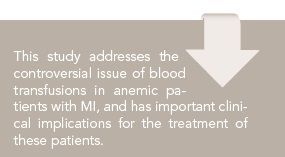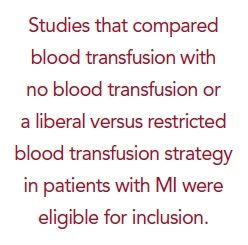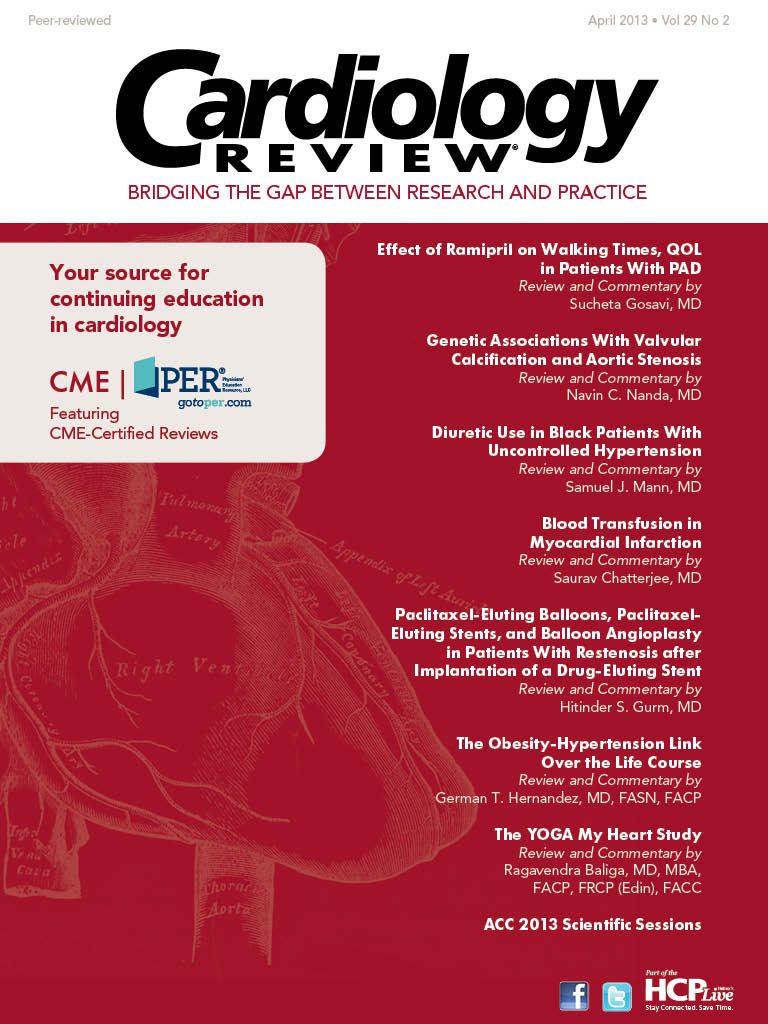Publication
Article
Cardiology Review® Online
Blood Transfusion in Myocardial Infarction

Saurav Chatterjee, MD
Review

Blood transfusions are often a preferred strategy to minimize cardiovascular events in anemic patients with myocardial infarction (MI),1 in spite of data from observational studies suggesting that blood transfusion is futile, and may even present the real possibility of harm.2,3 Until recently, randomized data have been lacking, and have not been definitive because of their small sample size and the nature of pilot trials,4 and their conflicting results have not contributed to clarifying the questions still remaining about the riskbenefit of blood transfusion in patients with MI.1
The study by Chatterjee et al5 attempted to answer questions about the impact of blood transfusion on hard, clinically relevant outcomes in anemic patients with MI and as such has important implications for the treatment of these patients.
Study Details

A search was carried out on MEDLINE, EMBASE, CINAHL, Scopus, Web of Science, and the Cochrane Central Register of Controlled Trials (CENTRAL) for relevant studies published in English between January 1966 and March 2012 containing the search terms “transfusion,” “myocardial infarction,” and “mortality.” The references of relevant studies and review articles were scanned. ClinicalTrials.gov and proceedings from major international cardiology meetings were also searched for relevant trials. Studies that compared blood transfusion with no blood transfusion or a liberal versus restricted blood transfusion strategy in patients with MI were eligible for inclusion. To be considered eligible for analysis, studies had to report on mortality and mean baseline hemoglobin/ hematocrit levels for both groups and confounding factors had to be adjusted between the groups by means of statistically acceptable methods such as regression analysis or propensity matching. Studies that assessed the effect of transfusion of components other than whole blood or red blood cells were excluded. Patient mean age ranged from 67 to 77.8 years; 45.9% to 99% of patients were male. Baseline hemoglobin level ranged from 8.91 g/dL to 13.9 g/dL.
Two reviewers independently selected studies for the review; disagreements were resolved by consensus. Study quality was assessed using the Newcastle- Ottawa Scale, which covered adequacy of selection, comparability of groups, and outcomes assessment. Publication bias was assessed with a funnel plot, the Egger’s regression test, and the trim-andfill method (Duval-Tweedie). Number needed to harm (NNH) was calculated. Subgroup analyses were planned for patients with STEMI and for patients with a hematocrit less than 30%. The study sequential analysis of diversity-adjusted information size for the outcome of allcause mortality was calculated. Sensitivity analyses excluded 1 study at a time. Multivariate meta-regression was used to assess the influence of the variables: follow- up period, history of bleeding, baseline creatinine level, baseline hemoglobin level, nadir of hemoglobin level, change in hemoglobin level during the hospital stay, and use of glycoprotein IIb or IIIa, thrombolytics, or antiplatelets.
Ten studies (1 randomized trial and 9 observational studies) met all criteria for review. A total of 203,655 patients were included for the analysis of events. Most studies were considered to have an intermediate risk of bias. Follow-up ranged from 1 month to 12 months where reported. There was no evidence of publication bias. Meta-analyses showed that blood transfusion/liberal blood transfusion increased all-cause mortality compared with no blood transfusion/restricted blood transfusion in anemic patients with MI (relative risk [RR], 2.91; 95% confidence interval [CI], 2.46-3.44; Ι² [quantitative measure of heterogeneity among included studies] = 92%; NNH = 8; 10 studies). Similar results were found when using adjusted mortality instead of the actual number of events (hazard ratio [HR], 2.25; 95% CI, 1.68-3.02; Ι² = 98%; 9 studies). Blood transfusion/ liberal blood transfusion was also associated with a higher risk of subsequent MI (RR 2.04; 95% CI, 1.06-3.93; Ι² = 98%; 7 studies). In summary, while 18% of the people died in the liberal transfusion arm, the mortality in the restricted transfusion arm was 10%. Subgroups of patients with STEMI and patients with a hematocrit of less than 30% showed no significant difference in mortality between liberal blood transfusion and comparator. Meta-regression showed that blood transfusion was associated with higher mortality after adjustment for different variables. Sensitivity analysis confirmed that no single study was the source of heterogeneity. Study sequential analysis6,7 of studies on all-cause mortality suggested firm evidence for a 20% increase in relative risk with blood transfusion or a liberal blood transfusion strategy, compared with no blood transfusion or a restricted blood transfusion strategy. The authors concluded that blood transfusion or a liberal blood transfusion strategy compared with no blood transfusion or a restricted blood transfusion strategy was associated with higher all-cause mortality, as well as higher subsequent MI rates in patients with MI.
References
1. Rao SV, Jollis JG, Harrington RA, et al. Relationship of blood transfusion and clinical outcomes in patients with acute coronary syndromes. JAMA. 2004;292:1555-1562.
2. Jani SM, Smith DE, Share D, et al. Blood transfusion and in-hospital outcomes in anemic patients with myocardial infarction undergoing percutaneous coronary intervention. Clin Cardiol. 2007;30(suppl 2):II49-II56.
3. Yang X, Alexander KP, Chen AY, et al; CRUSADE Investigators. The implications of blood transfusions for patients with non-STsegment elevation acute coronary syndromes: results from the CRUSADE National Quality Improvement Initiative. J Am Coll Cardiol. 2005;46:1490-1495.
4. Cooper HA, Rao SV, Greenberg MD, et al. Conservative versus liberal red cell transfusion in acute myocardial infarction (the CRIT Randomized Pilot Study). Am J Cardiol. 2011;108:1108-1111.
5. Chatterjee S, Wetterslev J, Sharma A, et al. Association of blood transfusion with increased mortality in myocardial infarction: a meta-analysis and diversity-adjusted study sequential analysis. (published online December 24, 2012) Arch Intern Med. 2013;173:132- 139. doi:10.1001/2013.jamainternmed.1001.
6. Brok J, Thorlund K, Gluud C, Wetterslev J. Trial sequential analysis reveals insufficient information size and potentially false positive results in many meta-analyses. J Clin Epidemiol. 2008;61:763-769.
7. Wetterslev J, Thorlund K, Brok J, Gluud C. Trial sequential analysis may establish when firm evidence is reached in cumulative metaanalysis. J Clin Epidemiol. 2008;61:64-75.
8. Carson JL, Hébert PC. Here we go again— blood transfusion kills patients? comment on “Association of blood transfusion with increased mortality in myocardial infarction: a meta-analysis and diversity-adjusted study sequential analysis.” (published online December 24, 2012.) Arch Intern Med. 2013;173:139- 140. doi:10.1001/2013.jamainternmed.1001.
9. Middelburg RA, van de Watering LM, van der Bom JG. Blood transfusions: good or bad? Confounding by indication, an underestimated problem in clinical transfusion research. Transfusion. 2010;50:1181-1183.
10. Myocardial Ischemia and Transfusion (MINT). ClinicalTrials.gov Identifier: NCT01167582. http://clinicaltrials.gov/ct2/ show/NCT01167582. Accessed 02/13/2013.
Commentary A Significant Mortality Risk Associated With Transfusion
The authors attempted to address a direct and relevant question and identified studies using documented inclusion criteria. Several relevant data sources were searched. The search was restricted to studies in English, so language bias remains a possibility. Suitable methods were employed in an attempt to reduce the risks of reviewer error and bias throughout the review process. Study quality was assessed using appropriate criteria. Information about individual studies was provided as available in the referenced publications. Well-accepted methods were used to pool data and assess heterogeneity. The authors acknowledged some limitations due to observational study designs, diverse patient characteristics, and the restriction to studies in English.
Despite significant heterogeneity (which the authors tried to explore by using sensitivity analysis and multivariate meta-regression), the pooled data consistently showed a significantly less harmful effect with no blood transfusion, and the directionality of the outcomes assessed consistently pointed to favorable outcomes with a restrictive transfusion strategy. An accompanying invited commentary8 suggests “confounding by indication”9 as a limitation. This remains a possibility, as the authors themselves acknowledge. However, it should be noted that an attempt was made to account for bleeding as an indication by including baseline hematocrit and nadir hematocrit, as well as drop in hematocrit from baseline in the multivariable model adopted for the adjusted risk estimates. The authors state that randomized controlled trials with adequate sample size and with low risk for bias were needed for more definitive conclusions. However, ongoing clinical trials continue to have inadequate sample size and thus are unlikely to be definitive.10 A less harmful effect was found with blood transfusion in a subgroup of patients with STEMI and with hematocrit of less than 30%, so future research should identify specific subgroups that may benefit from blood transfusion.
About the Author
Saurav Chatterjee, MD, is Clinical and Research Fellow in Preventive Cardiology and Outcomes Research at Brown University and Providence VAMC in Providence, RI, and will pursue a clinical cardiology fellowship at St Luke’s-Roosevelt Hospital of Columbia University beginning in July 2013. He graduated from Calcutta National Medical College with honors and was a resident in cardiology in Mercy Hospital, Kolkata, India, as well as trial coordinator of the CRESCENDO trial in Kolkata, India. He recently completed his residency in Internal Medicine from Maimonides Medical Center in Brooklyn, NY. Dr Chatterjee is the recipient of the 2012 Young Investigator Award for Health Outcomes and Population Genetics at the Annual Scientific Sessions of the American College of Cardiology 2012 in Chicago, and also the 2011 American Association of Cardiologists of Indian Origin (AACIO) Young Investigator Award for Interventional Cardiology and Electrophysiology.
Chatterjee S, Wetterslev J, Sharma A, Lichstein E, Mukherjee D. Association of blood transfusion with increased mortality in myocardial infarction: a meta-analysis and diversity-adjusted study sequential analysis. Arch Intern Med. 2013;173:132-139. Published online December 24, 2012. doi:10.1001/2013. jamainternmed.1001.






